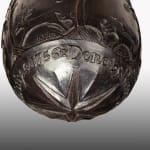Anglo-Indian ‘Bugbear’ Coconut Powder Flask and Ladle
Signed and dated: ‘done by Henry Hill, Gheria Fort, July 4, 1756’
Height: 5.25 inches (13.5cm)
Width: 3.25 inches (8.5cm)
Ladle
Height: 14.5 inches (37cm)
Further images
-
(View a larger image of thumbnail 1
)

-
(View a larger image of thumbnail 2
)

-
(View a larger image of thumbnail 3
)

-
(View a larger image of thumbnail 4
)

-
(View a larger image of thumbnail 5
)

-
(View a larger image of thumbnail 6
)

-
(View a larger image of thumbnail 7
)

-
(View a larger image of thumbnail 8
)

A colonial coconut ‘bugbear’ powder flask with a silvered mouthpiece or nozzle. Carved in relief with a native climbing a palm tree harvesting coconuts with a carrying bag; a stag hunt with hounds and a man blowing a horn; and a ‘Half Moon’ tavern with mica windows. The top depicting a man with mica eyes – his mouth being the silver nozzle or stopper.
The silver stopper replaced.
Mounted on later stands.
Together with a ladle with a turned laburnum handle, white metal, with a coconut bowl carved by the same hand depicting a stag hunt and with stellar decoration.
The bottom of the ‘bugbear’ carved with stellar decoration and inscribed: ‘done by Henry Hill, Gheria Fort, July 4, 1756’. Henry Hill was no doubt part of the British forces from the East India Company – a sailor or an officer on one of the fourteen ships which attacked Gheria Fort in 1756 (see information below). The flask clearly made to commemorate the victory at Gheria on 12th February 1756.
‘Bugbear’ coconut flasks: Edward H. Pinto, in his book ‘Treen and Other Wooden Bygones’, describes the coconut shell as ‘the raw material of all kind of nut treen’. He comments that: ‘Coconuts have also been used in their entirety as flasks, with carving used to accentuate the ‘bugbear’ marking’ (Edward H. Pinto, ‘Treen and Other Wooden Bygones’ (Bell & Hyman Limited, London, 1979), p.194).
‘Bugbear’ coconut flasks were carved by sailors or soldiers on long sea voyages who visited the East or West Indies in the late 18th/early 19th centuries. The ‘green’ coconut shells were easier to carve before they dried, whilst they were still fresh. Pinto comments that: ‘often they are valuable as historic documents of costume and episodes’ and illustrates three of the finest quality carvings (figures 203 and 204), which bear close similarities our flask with ‘the accentuation of the natural bugbear eyes into grotesque faces’. The largest of the nuts which Pinto depicts is a flask, also fitted with ‘eyes’ and a silver spout (ibid, p.194). There are examples of goblets and treen of similar workmanship attributed to French, English, Portuguese and Spanish sailors. French prisoners of war would carve them with a depiction of the Emperor Napoleon.
‘Gheria’ (Vijaydurg) Fort: Vijaydurg or ‘Gheria’ is the oldest fort in the district of Sindhudurg on the coast of Western India. In the 18th Century the fort was the base for a Maratha Sardar, Tulaji Angre, who disrupted the trade of the East India Company by attacking its ships. The Battle of Vijaydurg, also known as the siege of Vijaydurg, was fought between Tulaji Angre; and the joint forces of the East India Company and Nanasaheb Peshwa. In 1756, a large force from Bombay, led by Admiral Charles Watson and Lieutenant Colonel Robert Clive, assembled at Gheria on 11th February and began the attack the following day. The Maratha ships were anchored almost hull to hull at the mouth of the creek, close to the fort.
Amongst these was the Company’s ship ‘Restoration’, which caught fire. The fire spread until Tulaji Angre’s entire fleet was destroyed. The bombardment of the fort had caused considerable interior damage. Tulaji, meanwhile had left the fort and gone to the Peshwa’s camp seeking to negotiate, but he was taken prisoner. The garrison was asked to surrender and, in the absence of a response, Colonel Clive landed his marines, entered and captured the fort.
The construction of the fort: ‘Gheria’ fort was originally constructed between 1193AD and 1205AD during the regime of Raja Bhoj II of the Shilahar dynasty. Adil Shahis of Bijapur captured the fort in the 16th century and it was rebuilt. It was originally called ‘Gheria’, due to its situation close to the village of ‘Girye’, but the Bijapur Sultans renamed it ‘Vijaydurg’ – the fort of victory, with ‘Vijay’ meaning ‘Victory’ and ‘Durg’ meaning ‘Fort’. The fort was further restructured by Shivaji Maharaj in 1654.








